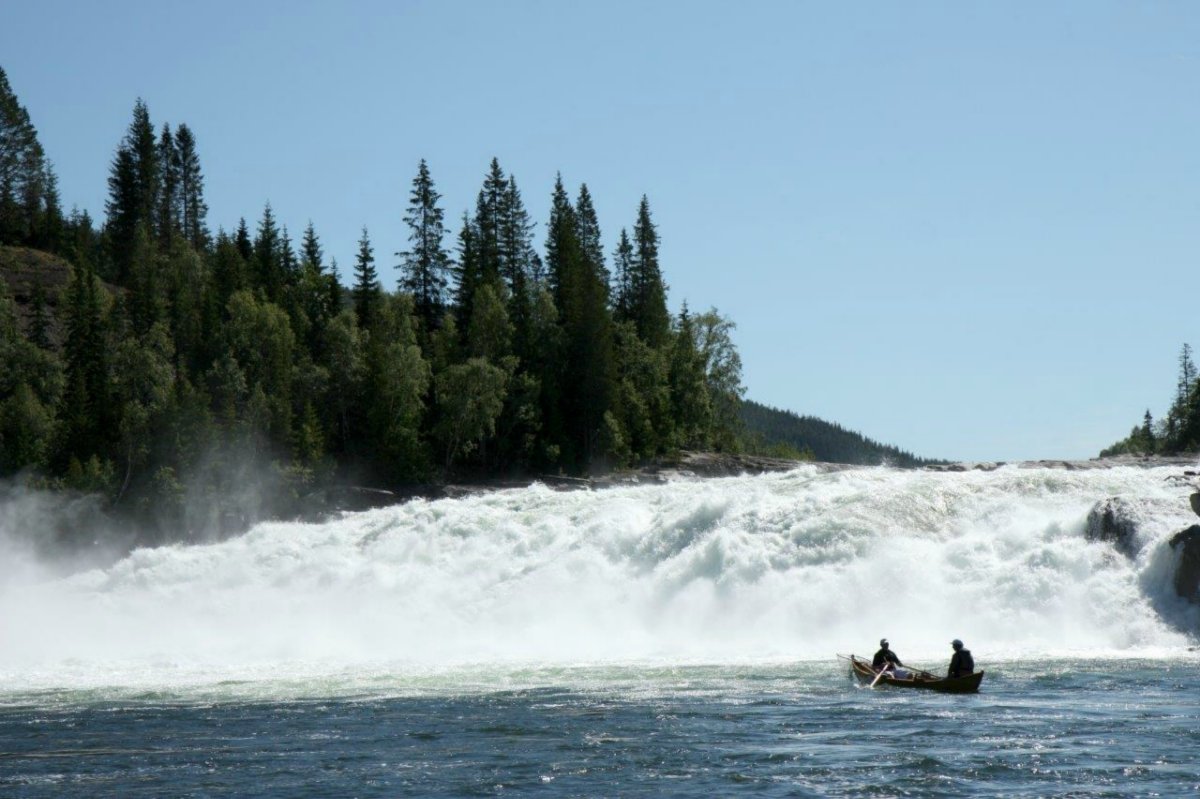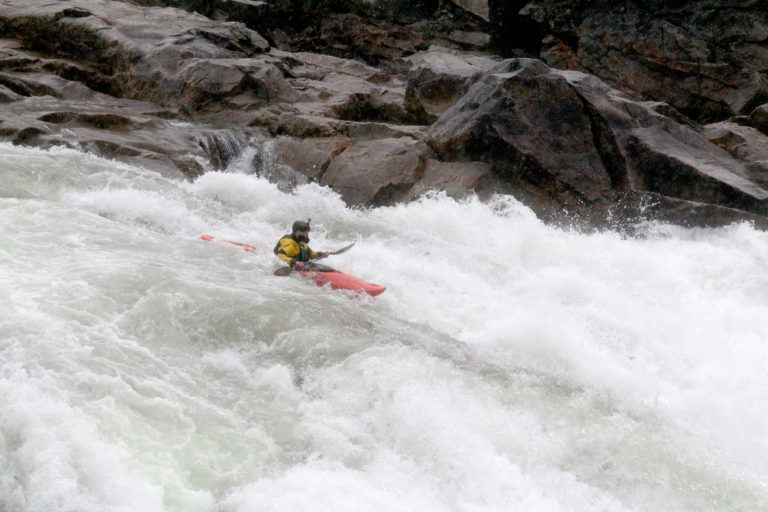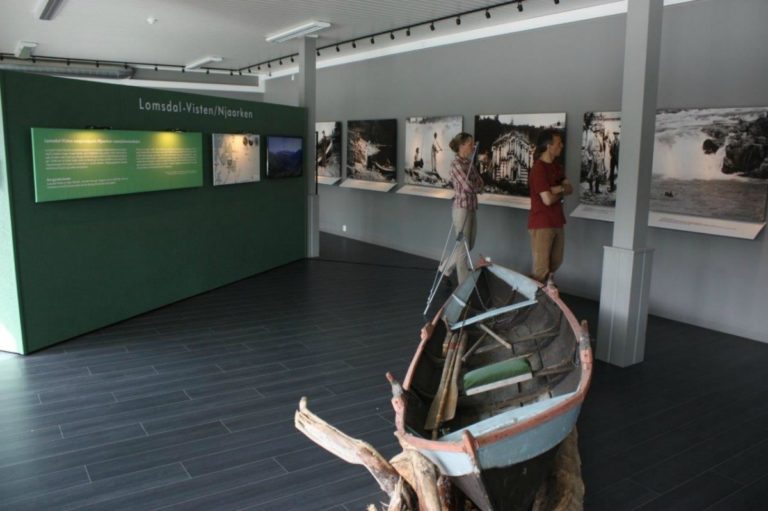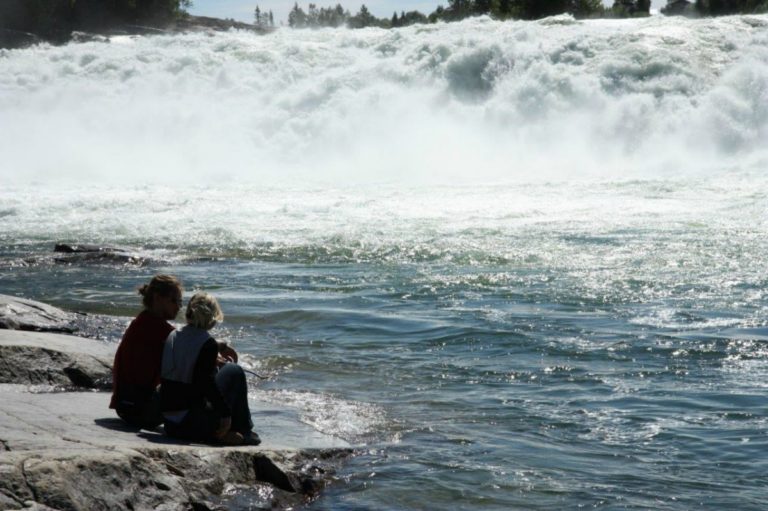Laksforsen stands at 17m high, making it far from Norway’s highest waterfall. However, it is the mass amount of water transported by the fall that is most impressive. The water can flow at 1800 cubic metres a second, meaning the museum hall at Laksforsen would be filled in just 0.2 seconds. These are huge quantities of water we are talking about!
The water levels change over the year
In the fall of 2014, the water level rose from 200 cubic meters per second to 1300 cubic meters overnight. Large amounts of rainfall can cause the water levels to multiply rapidly. This is due to the shallow rocky terrain, the rain is not absorbed by the soil, ending up directly in the river. The flow is at its peak during the snow melt in the spring, but also heavy summer showers and autumn rains cause the river to rise rapidly. In winter, the water level is at its lowest, as much of the precipitation falls as snow and settles without entering the water stream.
Some are brave enough to kayak down the waterfall
Believe it or not; some actually choose to paddle in a river kayak down Laksforsen. The river and the many tributaries are among the world’s best places to go river paddling. There is everything from quiet sections for beginners to the actual torque of the fall itself.
Practical information about Laksforsen
Laksforsen is a waterfall along the river Vefsna, in Grane kommune inland Helgeland. The waterfall is a stop on the E6 route, and is easy to visit.
The waterfall museum has a small gallery and exhibit with cafe. Check out their website for more information. For more information about the region, check out the Visit Helgeland website.
The river was a vital food source for the community
The web is one of the country’s finest salmon rivers. Salmon fishing was an vital resource for the people living along the river. They fished with nets which crossed the river to catch as many of the fish as possible. Seasonal workers had in their employment contract that they should not get salmon for dinner more than 5 times a week. There was always enough salmon in the summer, and in Mosjøen, the river salmon was put in a container with oil for preservation.
English ‘salmon lords’ invaded from the mid 19th Century onwards
From the 1850s onwards, however, came the British “salmon lords” to fish salmon. These members of the aristocracy had so much money that they did not need to work, so when it was communicated that the salmon were moving up the river, they sat on the boat to Norway and made their way up the valley with workers. At one fishing spot, Forsjordforsen, the English could take 6 tonnes of salmon in one summer.
The English were summer visitors
The salmon lords first rented local farms. The people on the farms moved out and left the main house to the English for a fee. Eventually the English built their own villas, one of them from 1935 looks out over Laksforsen. The salmon lords took advantage of the river up until 1964, when fishing rights for foreigners were terminated.
Specially adapted boats improved accessibility along the river
An old boat type used in Vefsna was the so called ‘ålvfæringen’ (river crosser) (ålv is the local word for river). The boat was specially adapted to streams and low water levels. They have barely a keel, and a five meter boat weighs only around 70 kilos. The boats were built at home in the living room on the farms, since there was good lighting and warmth there. To get the boat out, they would traport it through the living room window. The boat type was transported by the English to Canada and Singapore.
Gyrodactilus nearly wiped out the salmon
The salmon parasite gyrodactilus salaris, which has ravaged many Norwegian salmon rivers, has also hit the river, where for 40 years the stocks of salmon have been steadily declining. In 2011-12, therefore, the river was treated below Laksforsen with rotenon. Rotenon is a poison that kills all fish, and the parasite that uses them as a host. Now the salmon levels are increasing to large numbers, and from 2017 the river opened for salmon fishing below the falls. There is also a stock of sea trout and river trout, and in Vefsna there is also grayling.






